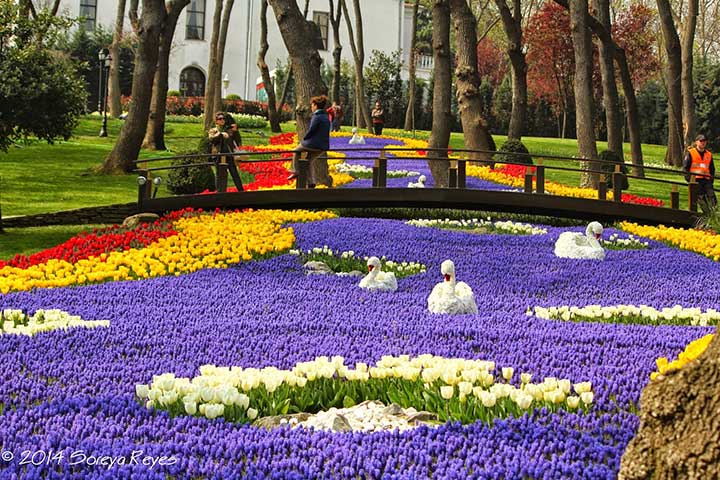Dating from 1718 to 1730, the Tulip Era of the Ottoman Empire was a momentary period that the Sultan and the public celebrated with music, festivals, ceremonies, and dances. Numerous tulips embellished the capital that most of them were poetically named such as Blue Pearl, Light of Dawn, The Divine Throne and Ruby Drop and represented a period of peace, creativity and the luxurious entertainment since the bulbs were imported at a considerable expense. As the Court Poet, Nedim wrote…
“Let us have fun, let us all dance and play, for it is tulip time!”
The Name Origin
The period gets its name from inhabitants of the palace who had the passion for tulips which especially were topnotch and artistic. An early 20th-century historian later called this as the Tulip Era that compliments the symbolizing of art and joy of life for over 12 years.
The History
During the dynasty of Sultan Ahmed III, after 4 centuries of wars, conquests, and defeats; the Ottomans abruptly decided to enjoy the beauty of “la dolce vita” turning the military and diplomacy into wine, women, and songs. The French Ambassador, de Villeneuve, stated that the Court was rather concentrated on new entertainments, regularly in cavalcades or enjoying the waves of Bosphorus and the Golden Horn on their boats. After repeated requests, he was finally able to get an appointment from the Grand Vizier Damat Ibrahim Pasha and the only thing they could talk about was tulips.
They were everywhere -not only in the beautiful courtyards and gardens of Topkapi Palace but also around the houses of the poor. Artists at different forms honored this symbolic Turkish flower on tiles, textiles, embroideries, miniatures, paintings, hats, slippers, tombstones, rowboats, glass or utensils since it could go with anything with creativity.
Indigenous to a wide area of Central Asia Minor where the Turks had already clouted for many centuries, it became the primary flower of the Ottomans that also had a religious significance since in the Arabic calligraphy of the Ottomans used, the name of tulip bears a resemblance of God. However, the origin of the word refers to dulband or turban that was named after its shape by the Europeans and British travelers.
Another great story was written by the Ambassador Busbecq visiting the court of Suleyman the Magnificent as the Deputy of Austrian Emperor in 1554:
“A myriad of flowers… They were everywhere and the Turks were so obsessed with the flowers that even the marching troops were strictly warned not to walk over them.”
This gives the idea that the Turkish flower was already cultivated in the Ottoman gardens and classic poetry during the reign of Sultan Suleyman ascended the throne in 1520. He returned to Vienna with some bulbs and this was the first time that the Swiss botanist named Konrad Gesner saw Garden Tulips and mentioned it in his Book of Garden Flowers back in 1561. Later a famous Dutch botanist called Clusius took some bulbs from Busbecq to develop new varieties and in a short period, these flowers perfectly took over the imagination of the European spreading the obsession later called Tulipomania swept through Holland.
While Ottomans breed the varieties of their own, they still imported dozens of different types from Holland and other countries. Around 1720, there were already over 900, each with a special name and around 1750 varieties had been registered as stated in a later document. It became such a great symbol of wealth that some of the varieties were sold for 1000 gold for each.
No matter what, this creative spirit continued where festivals were organized and last for 40 days and 40 nights as the idiom says. At nights, up to 25000 lanterns lighted up Istanbul as well as over 6000 fireworks decorating the sky. The infinite varieties of the flowers were implemented into the art and entertainment as well with the music, dance, mock battles, comedy, acrobats, magic show, games and artisans presenting their works one after another.
At night, 15 to 25 thousand lanterns illuminated the city and 5000 to 7000 firecrackers decked the skies. Music, dance, mock battles, comedy, acrobatics, magic shows, javelin games, torch pageants- an inexhaustible diversity of entertainment.

Finally, for about 12 years, the era gave a great new direction and encouragement to new aspects to most of Ottoman Art which also led strength to the relationship with Europe. It also introduced the printed press for the publication of various books in Turkish and momentum was gained for science, libraries, and translations.
Istanbul Tulip Festival 2021
Dates: 24 – 29 April 2021
Hours: 14:00 – 19:00
Locations: Emirgan Park, Goztepe 60. Yil Parki, Sultanahmet Area
Let us enrich the day!
Since 2006, Istanbul Municipality has planted millions of flowers, literally in any open space. So far, the record was about 30 million planted back in 2016! If you are traveling to Istanbul within April and love flowers; make sure to visit Sariyer by Bosphorus to get to Emirgan Park which is considered as a central location to see some breathtaking displays. Sariyer is included in our private Bosphorus cruise tour for a lunch break at a fish restaurant and we can include some other visits for the day if preferred.



